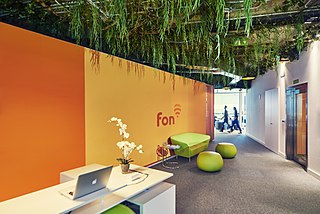Related Research Articles

A wireless network is a computer network that uses wireless data connections between network nodes. Wireless networking allows homes, telecommunications networks and business installations to avoid the costly process of introducing cables into a building, or as a connection between various equipment locations. Admin telecommunications networks are generally implemented and administered using radio communication. This implementation takes place at the physical level (layer) of the OSI model network structure.

Wireless community networks or wireless community projects or simply community networks, are non-centralized, self-managed and collaborative networks organized in a grassroots fashion by communities, non-governmental organizations and cooperatives in order to provide a viable alternative to municipal wireless networks for consumers.

Wi-Fi is a family of wireless network protocols based on the IEEE 802.11 family of standards, which are commonly used for local area networking of devices and Internet access, allowing nearby digital devices to exchange data by radio waves. These are the most widely used computer networks, used globally in home and small office networks to link devices and to provide Internet access with wireless routers and wireless access points in public places such as coffee shops, hotels, libraries, and airports to provide visitors.

Wireless communication is the transfer of information (telecommunication) between two or more points without the use of an electrical conductor, optical fiber or other continuous guided medium for the transfer. The most common wireless technologies use radio waves. With radio waves, intended distances can be short, such as a few meters for Bluetooth or as far as millions of kilometers for deep-space radio communications. It encompasses various types of fixed, mobile, and portable applications, including two-way radios, cellular telephones, personal digital assistants (PDAs), and wireless networking. Other examples of applications of radio wireless technology include GPS units, garage door openers, wireless computer mouse, keyboards and headsets, headphones, radio receivers, satellite television, broadcast television and cordless telephones. Somewhat less common methods of achieving wireless communications involve other electromagnetic phenomena, such as light and magnetic or electric fields, or the use of sound.

In computer networking, a wireless access point, or more generally just access point (AP), is a networking hardware device that allows other Wi-Fi devices to connect to a wired network or wireless network. As a standalone device, the AP may have a wired connection to a router, but, in a wireless router, it can also be an integral component of the router itself. An AP is differentiated from a hotspot, which is a physical location where Wi-Fi access is available.

Worldwide Interoperability for Microwave Access (WiMAX) is a family of wireless broadband communication standards based on the IEEE 802.16 set of standards, which provide physical layer (PHY) and media access control (MAC) options.

Fon Wireless Ltd. is a for-profit company incorporated and registered in the United Kingdom that provides wireless services. Fon was founded in Madrid, Spain, in 2006, by Martín Varsavsky where it headquarters most of its operations.

A municipal wireless network is a citywide wireless network. This usually works by providing municipal broadband via Wi-Fi to large parts or all of a municipal area by deploying a wireless mesh network. The typical deployment design uses hundreds of wireless access points deployed outdoors, often on poles. The operator of the network acts as a wireless internet service provider.
Wireless Nomad (wirelessnomad.com) was a for-profit cooperative based in Toronto, Canada providing subscriber-owned home and business Internet access along with free Wi-Fi wireless Internet access and music to over a hundred nodes, making it the largest free Wi-Fi network in the country at the time. It was founded by Steve Wilton and Damien Fox in January 2005, and turned its DSL internet connections over to private ISP TekSavvy in March 2009. All WiFi nodes were subsequently shut down.
A neighborhood Internet service provider (NISP) is a small scale broadband Internet service provider targeted at a single subdivision or neighborhood. They are built in a neighborhood to provide Internet access to residents in the community, often using rooftop antennas in a hub-and-spoke arrangement to bridge the last few hundred feet to the residences. Such a network requires a local network engineer to maintain network integrity and monitor the quality of service.
The DG834 series are popular ADSL modem router products from Netgear. The devices can be directly connected to the phone line and establish an ADSL broadband Internet connection to the ISP and share it among several computers via 802.3 Ethernet and 802.11b/g wireless data links.
Long-range Wi-Fi is used for low-cost, unregulated point-to-point computer network connections, as an alternative to other fixed wireless, cellular networks or satellite Internet access.
Piggybacking on Internet access is the practice of establishing a wireless Internet connection by using another subscriber's wireless Internet access service without the subscriber's explicit permission or knowledge. It is a legally and ethically controversial practice, with laws that vary by jurisdiction around the world. While completely outlawed or regulated in some places, it is permitted in others.

Boingo Wireless is an American company that designs, builds and manages wireless networks. Its public and private networks include distributed antenna systems (DAS), small cells, macro towers and more than one million Wi-Fi hotspots around the world. The company operates networks for airports, transit stations, stadiums, military bases, hospitals and commercial properties. In December 2022, the company announced it was moving its headquarters to Frisco, Texas, and would maintain regional offices in Los Angeles, New York, Chicago and Las Vegas. The company was listed on the Nasdaq until it was acquired by investment firm Digital Colony Management LLC in 2021.
In telecommunications, white spaces refer to radio frequencies allocated to a broadcasting service but not used locally. National and international bodies assign frequencies for specific uses and, in most cases, license the rights to broadcast over these frequencies. This frequency allocation process creates a bandplan which for technical reasons assigns white space between used radio bands or channels to avoid interference. In this case, while the frequencies are unused, they have been specifically assigned for a purpose, such as a guard band. Most commonly however, these white spaces exist naturally between used channels, since assigning nearby transmissions to immediately adjacent channels will cause destructive interference to both.

Mahabir Pun is a Nepali researcher, teacher, social entrepreneur and an activist known for his work in applying wireless technologies to develop remote areas of the Himalayas, also known as the Nepal Wireless Networking Project. He is a widely known figure in Nepal, and his work has been recognised by the Ashoka Foundation, the Ramon Magsaysay Foundation, [University of Nebraska Kearney],and Global Ideas Bank.
Wi-Fi positioning system is a geolocation system that uses the characteristics of nearby Wi‑Fi access point to discover where a device is located.

South African wireless community networks are wireless networks that allow members to talk, send messages, share files and play games independent of the commercial landline and mobile telephone networks. Most of them use WiFi technology and many are wireless mesh networks. A wireless community network may connect to the public switched telephone network and/or the Internet, but there are various restrictions on connectivity in South Africa. Wireless community networks are particularly useful in areas where commercial telecommunications services are unavailable or unaffordable.
Radwin is a wireless communications manufacturing company that produces wireless communications systems used by telecoms carriers, city and town councils, remote communities, ISPs, WISPs, and private networks. It also creates hardware for transportation applications such as metro systems, bus networks, ferries, airports, and vehicles such as patrol vehicles, manned and unmanned heavy machinery used in mines and ports. The hardware is used for applications, including mobile and IP backhaul, home and enterprise wireless broadband access, private network connectivity, and video surveillance transmission. As part of the Smart City initiative in India by Prime Minister Narendra Modi, Radwin entered a partnership with Avaya in 2016.

Cees Links is a Dutch entrepreneur and the founder and CEO of GreenPeak Technologies (2004), a fabless semiconductor company for Smart Home and Internet of things (IoT) applications, in 2016 sold to Qorvo Inc., a USA-based semi-conductor/technology company.
References
- 1 2 Wolter Lemstra; Leo Van Audenhove; et al. (2010). "Wi-Fie-based community networks: Wirelss Leiden". The innovation journey of Wi-Fi: the road to global success. Cambridge University Press. pp. 175–196. ISBN 978-0-521-19971-1 . Retrieved 6 October 2011.
- ↑ Rob Flickenger (2003). Building wireless community networks. O'Reilly. pp. 127–128. ISBN 0-596-00502-4.
- ↑ Stefan Jeu Sjraar Verhaegh (2010). How community innovation works : a material-semiotic analysis of the wireless Leiden Wi-Fi network. University of Twente. doi:10.3990/1.9789036531290. ISBN 9789036531290.
{{cite book}}:|work=ignored (help) - ↑ "WiFi network will be phased out". February 2022. Retrieved 18 April 2023.